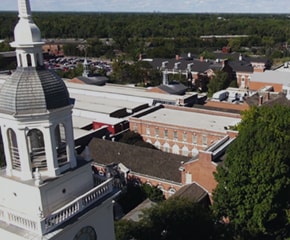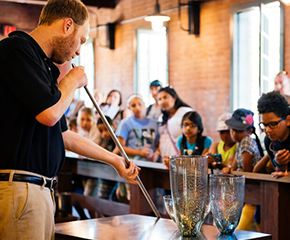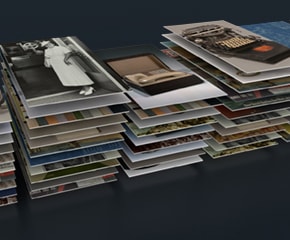
Virgil M. Exner Papers
Virgil Exner was an automobile designer who worked for General Motors, Studebaker, Chrysler, and his own company Virgil Exner Inc. The collection consists of concept and engineering drawings, renderings, photographs, correspondence and art work.
Biographical / Historical Note
Born in 1909 in Ann Arbor, Michigan, Virgil Max Exner exhibited artistic talent and an interest in automobile design early in life. He studied art at the University of Notre Dame in Indiana (1927-1928) but left before completing a degree to take employment...
MoreBorn in 1909 in Ann Arbor, Michigan, Virgil Max Exner exhibited artistic talent and an interest in automobile design early in life. He studied art at the University of Notre Dame in Indiana (1927-1928) but left before completing a degree to take employment as a layout artist and illustrator with a South Bend, Indiana firm, Advertising Artists. It was while at Advertising Artists, that Exner began his association with Studebaker Corporation, who held an account with the agency. Exner's illustrations for Studebaker catalogs are among his finest work in this period.
In 1934, Exner moved to Harley Earl's Art and Colour Section at General Motors Corporation, where he was quickly promoted to the position of Chief Designer for Pontiac Studios. After only four years at GM, however, Exner was lured away to join Raymond Loewy's industrial design firm and was placed in charge of the Studebaker Corporation account. Now, as chief styling engineer for Studebaker, Exner was responsible for developing several new lines of automobiles: the first Champion in 1939, a new line of Champion, Commander, and President models in 1941, and the 1947 post-war model, the Starlight coupe.
In 1949, Exner joined Chrysler Corporation as head of the newly established Advanced Design Studio. By 1953, Exner was put in charge of all corporation styling, and in 1957, he was named Vice-president of Styling, a post he held until his retirement from Chrysler in 1961. While at Chrysler, Exner was responsible for the development of sixteen "idea" cars, built by the Ghia firm of Italy. These cars were used by Chrysler as styling survey and sales promotion products. In the area of production vehicles, Exner was responsible for the "Forward Look" lines of 1955 and 1956. His revolutionary line of 1957 "wedge theme" cars were the culmination of the Forward Look line and epitomize Exner's contribution to Chrysler Corporation, to the automobile industry, and to the art of automotive styling.
Exner resigned from Chrysler in 1961 to begin his own design and development firm, Virgil Exner Inc., with his son Virgil, Jr., also an automotive designer. Most notable was Virgil Exner Sr. series of "classic revivals" (redesigning classic cars for a modern market) such as his design of the 1963 Mercer-Cobra, the 1966 Duesenberg, and his late-1960s Stutz Blackhawk. Until his death in 1973, Exner and his son were also involved in a variety of automotive and pleasure boat design initiatives.
LessScope and Content Note
The materials comprising the collection were received from Virgil Exner Jr. in 1990. Prior to donating the collection to the Henry Ford Museum & Greenfield Village Research Center, Exner Jr. had organized the materials into numerous groups and prepared...
MoreThe materials comprising the collection were received from Virgil Exner Jr. in 1990. Prior to donating the collection to the Henry Ford Museum & Greenfield Village Research Center, Exner Jr. had organized the materials into numerous groups and prepared detailed labels identifying the specific design project or period in his father's career which they documented. This original arrangement was retained as the basis for the collection's arrangement; only obvious mistakes in filing were corrected.
The collection has been divided into four series. The Student Work series, 1909-1928 (.2 cubic feet and oversize) is comprised of adolescent drawings, student sketches and early design work; Design Projects series, 1928-1973 consists of five subseries arranged by company. The Advertising Artists subseries, 1928-1934 (.2 cubic ft. and oversize), contains concept drawings, renderings, and product literature detailing Exner's design work, particularly with Studebaker. The General Motors subseries, 1934-1938 (.2 cubic ft. and oversize) 1934-1938 contains concept drawings, renderings, photographs and product literature relating to GM design work and includes an early Exner patent for a bumper. The Raymond Loewy subseries, 1938-1972 (.4 cubic ft. and oversize) documents Exner's work for Raymond Loewy and Studebaker and includes concept drawings of automobiles and race cars, photographs of automobiles and design facilities and personal, a midget racing engineering notebook. The Chrysler subseries, 1949-1961 (1.4 cubic ft. and oversize),is arranged by date and project and is made up of concept and engineering drawings, renderings, product literature, photographs, and periodical articles (some by Virgil Exner). The Virgil Exner Inc. subseries, 1961-1973 (2 cubic ft. and oversize), is organized by project and contains concept and engineering drawings, renderings, product literature, photographs, and transparencies and deals with Exner's work on both automobile and boat design. The Art Work series, 1930-1973 (oversize) contains actual art work created by Virgil Exner and consists of watercolors, acrylics, paint on canvas and numerous charcoal and pencil sketches of non automotive subjects. The Virgil Exner Jr. series, 1940-1959 (.1 cubic ft. and 1 oversize folder) collects together artistic and biographical materials related to Virgil Jr. It should be noted, however, that much of the design work completed by Virgil Exner Inc. represents collaboration between Virgil Sr. and Jr., and that often the principal design responsibility was not recorded.
Additional biographical information on Virgil M. Exner Sr. and Jr. can be obtained in the bound Automotive Design Oral History Virgil M. Exner Sr. and Jr.
LessCollection Details
Object ID: 90.1.1741.0
Creator: Exner, Virgil M. (Virgil Max), 1909-1973
Inclusive Dates: 1913-1986
Size: 6 cubic ft. and 23 oversize boxes
Language: English
Collection Access & Use
Item Location: Benson Ford Research Center
Access Restrictions: The papers are open for research.
Credit: From the Collections of the Henry Ford. Gift of Virgil M. Exner, Jr.
Related Objects
Digitized Artifacts From This Collection
In many cases, not all artifacts have been digitized.
Contact us for more information about this collection.
"Ballerina on Stage" by Virgil M. Exner, 1957
Artifact
Pastel (Visual work)
Date Made
1957
Summary
Though best remembered for his design work under Harley Earl at General Motors Corporation, at Raymond Loewy's industrial design firm, at Studebaker Corporation, and in Chrysler Corporation's Advanced Styling Studio, Virgil Exner was also an artist at home. He made time for the fine arts, especially while recuperating from a 1956 heart attack. Exner created this expressive pastel in 1957.
Object ID
90.1.1741.136
Credit
From the Collections of the Henry Ford. Gift of Virgil M. Exner, Jr.
Location
By Request in the Benson Ford Research Center
Get more details in Digital Collections at:
"Ballerina on Stage" by Virgil M. Exner, 1957
What is The Henry Ford?
The national attraction for discovering your ingenuity while exploring America’s spirit of innovation. There is always much to see and do at The Henry Ford.
Light Snow in the Pass, Painted by Virgil M. Exner circa 1970
Artifact
Acrylic painting (Visual work)
Date Made
circa 1970
Summary
Though best remembered for his design work under Harley Earl at General Motors Corporation, at Raymond Loewy's industrial design firm, at Studebaker Corporation, and in Chrysler Corporation's Advanced Styling Studio, Virgil Exner made time to practice the fine arts. Exner painted this scenic piece during "retirement" (he continued work on design projects from home until his death in late 1973).
Keywords
United States, Western United States
Acrylic paintings (Visual works)
Object ID
90.1.1741.248
Credit
From the Collections of the Henry Ford. Gift of Virgil M. Exner, Jr.
Location
By Request in the Benson Ford Research Center
Get more details in Digital Collections at:
Light Snow in the Pass, Painted by Virgil M. Exner circa 1970
What is The Henry Ford?
The national attraction for discovering your ingenuity while exploring America’s spirit of innovation. There is always much to see and do at The Henry Ford.
Snow in the Alps, Painted by Virgil M. Exner, 1958
Artifact
Watercolor (Painting)
Date Made
1958
Summary
Though best remembered for his design work under Harley Earl at General Motors Corporation, at Raymond Loewy's industrial design firm, at Studebaker Corporation, and in Chrysler Corporation's Advanced Styling Studio, Virgil Exner was also an artist at home. He made time for the fine arts, especially while recuperating from a 1956 heart attack. Exner painted this scenic watercolor in 1958.
Keywords
Object ID
90.1.1741.25
Credit
From the Collections of the Henry Ford. Gift of Virgil M. Exner, Jr.
Location
By Request in the Benson Ford Research Center
Get more details in Digital Collections at:
Snow in the Alps, Painted by Virgil M. Exner, 1958
What is The Henry Ford?
The national attraction for discovering your ingenuity while exploring America’s spirit of innovation. There is always much to see and do at The Henry Ford.
Alpine Snow Scene, 1957
Artifact
Watercolor (Painting)
Date Made
1957
Summary
Though best remembered for his design work under Harley Earl at General Motors Corporation, at Raymond Loewy's industrial design firm, at Studebaker Corporation, and in Chrysler Corporation's Advanced Styling Studio, Virgil Exner was also an artist at home. He made time for the fine arts, especially while recuperating from a 1956 heart attack. Exner painted this scenic watercolor in 1958.
Object ID
90.1.1741.245
Credit
From the Collections of the Henry Ford. Gift of Virgil M. Exner, Jr.
Location
By Request in the Benson Ford Research Center
Get more details in Digital Collections at:
Alpine Snow Scene, 1957
What is The Henry Ford?
The national attraction for discovering your ingenuity while exploring America’s spirit of innovation. There is always much to see and do at The Henry Ford.
French Village Scene, 1959
Artifact
Watercolor (Painting)
Date Made
1959
Summary
Though best remembered for his design work under Harley Earl at General Motors Corporation, at Raymond Loewy's industrial design firm, at Studebaker Corporation, and in Chrysler Corporation's Advanced Styling Studio, Virgil Exner was also an artist at home. He made time for the fine arts, especially while recuperating from a 1956 heart attack. Exner painted this scenic watercolor in 1959.
Keywords
Object ID
90.1.1741.246
Credit
From the Collections of the Henry Ford. Gift of Virgil M. Exner, Jr.
Location
By Request in the Benson Ford Research Center
Get more details in Digital Collections at:
French Village Scene, 1959
What is The Henry Ford?
The national attraction for discovering your ingenuity while exploring America’s spirit of innovation. There is always much to see and do at The Henry Ford.
Afternoon Sun, 1960
Artifact
Watercolor (Painting)
Date Made
1960
Summary
Though best remembered for his design work under Harley Earl at General Motors Corporation, at Raymond Loewy's industrial design firm, at Studebaker Corporation, and in Chrysler Corporation's Advanced Styling Studio, Virgil Exner was also an artist at home. He made time for the fine arts, especially while recuperating from a 1956 heart attack. Exner painted this scenic watercolor in 1960.
Object ID
90.1.1741.247
Credit
From the Collections of the Henry Ford. Gift of Virgil M. Exner, Jr.
Location
By Request in the Benson Ford Research Center
Get more details in Digital Collections at:
Afternoon Sun, 1960
What is The Henry Ford?
The national attraction for discovering your ingenuity while exploring America’s spirit of innovation. There is always much to see and do at The Henry Ford.
Design Drawing by Virgil Exner for Studebaker Corporation, circa 1945
Artifact
Design drawing
Summary
Virgil Exner's long career in automotive design included time with General Motors, Raymond Loewy Associates, and Studebaker -- for which he produced this work. Exner is best remembered for his tenure as design head at Chrysler, where his dramatic "Forward Look" characterized the company's vehicles from 1955 to 1961.
Keywords
Object ID
90.1.1741.15
Credit
From the Collections of the Henry Ford. Gift of Virgil M. Exner, Jr.
Location
By Request in the Benson Ford Research Center
Get more details in Digital Collections at:
Design Drawing by Virgil Exner for Studebaker Corporation, circa 1945
What is The Henry Ford?
The national attraction for discovering your ingenuity while exploring America’s spirit of innovation. There is always much to see and do at The Henry Ford.
"Ballerina in Dressing Room" by Virgil M. Exner, 1957
Artifact
Pastel (Visual work)
Date Made
1957
Summary
Though best remembered for his design work under Harley Earl at General Motors Corporation, at Raymond Loewy's industrial design firm, at Studebaker Corporation, and in Chrysler Corporation's Advanced Styling Studio, Virgil Exner was also an artist at home. He made time for the fine arts, especially while recuperating from a 1956 heart attack. Exner created this expressive pastel in 1957.
Object ID
90.1.1741.24
Credit
From the Collections of the Henry Ford. Gift of Virgil M. Exner, Jr.
Location
By Request in the Benson Ford Research Center
Get more details in Digital Collections at:
"Ballerina in Dressing Room" by Virgil M. Exner, 1957
What is The Henry Ford?
The national attraction for discovering your ingenuity while exploring America’s spirit of innovation. There is always much to see and do at The Henry Ford.
Winslow to Gallup, Painted by Virgil M. Exner circa 1971
Artifact
Acrylic painting (Visual work)
Date Made
circa 1971
Summary
Though best remembered for his design work under Harley Earl at General Motors Corporation, at Raymond Loewy's industrial design firm, at Studebaker Corporation, and in Chrysler Corporation's Advanced Styling Studio, Virgil Exner made time to practice the fine arts. Exner painted this scenic piece during "retirement" (he continued work on design projects from home until his death in late 1973).
Object ID
90.1.1741.26
Credit
From the Collections of the Henry Ford. Gift of Virgil M. Exner, Jr.
Location
By Request in the Benson Ford Research Center
Get more details in Digital Collections at:
Winslow to Gallup, Painted by Virgil M. Exner circa 1971
What is The Henry Ford?
The national attraction for discovering your ingenuity while exploring America’s spirit of innovation. There is always much to see and do at The Henry Ford.












